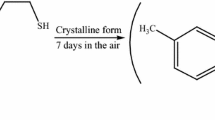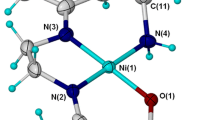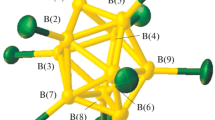Abstract
A series of stable pentasulfide complexes of the common base metals, Mn, Fe, Co, Ni, Cu and Zn exist in aqueous solutions at ambient temperatures. Pure sodium pentasulfide was prepared and reacted with the divalent cations of Mn, Fe, Co, Ni, Cu and Zn in aqueous solution at ambient temperature. The S52- complexes were found to exist as determined by voltammetric methods.
Pentasulfide complexes with compositions assigned as [M(η1-S5)] and [M2(μ- S5)]2+ occur for Mn, Fe, Co and Ni where only one terminal S atom in the S52- binds to one metal (η1 = mono-dentate ligand or M-S-S-S-S-S, μ = ligand bridging two metal centers or M-S-S-S-S-S-M). Conditional stability constants are similar for all four metals with log β1 between 5.3 and 5.7 and log β2 between 11.0 and 11.6. The constants for these pentasulfide complexes are similar to the tetrasulfide complexes and are approximately 0.4–0.8 log units higher than for comparable bisulfide complexes [M(SH)]+ as expected based on the higher nucleophilicity of S52- compared to HS-. Voltammetric results indicate that these are labile complexes.
As with the bisulfide and tetrasulfide complexes, Zn(II) and Cu(II) are chemically distinct from the other metals. Zn(II) reacts with pentasulfide to form a stable monomeric pentasulfide chelate, [Zn(η1-S5)] with log β = 8.7. Cu(II) reacts with pentasulfide to form a complex with the probable stoichiometry [Cu(S5)]2 with log β estimated to be 20.2. As with the other four metals, these complexes are comparable with the tetrasulfide complexes. Discrete voltammetric peaks are observed for these complexes and indicate they are electrochemically inert to dissociation. Reactions of Zn(II) and Cu(II) also lead to significant breakup of the polysulfide.
The relative strength of the complexes is Cu > Zn > Mn, Fe, Co, Ni. Cu displaces Zn from [Zn(η1- S5)] and both Cu and Zn displace Mn, Fe, Co and Ni from their pentasulfide complexes.
Similar content being viewed by others
References
Bianchi, A., Domenech, A., Garcia-Espana, E., and Luis, S. V. (1993) Electrochemical studies on anion coordination chemistry. Application of the moe-ratio method to competitive cyclic voltammetry. Anal. Chem. 65, 3137-3142.
Bond, A. M. (1980) Modern Polarographic Methods in Analytical Chemistry. Marcel Dekker, New York, p. 518.
Burgess, J. (1989) Ions in Solution: Basic Principles of Chemical Interactions. John Wiley, New York.
Chadwell, S. J., Rickard, D., and Luther, III, G. W. (submitted) Electrochemical evidence for metal polysulfide complexes: tetrasulfide complexes with Mn2+, Fe2+, Co2+, Ni2+, Cu2+ and Zn2+.
Chen, K. Y. and Morris, J. C. (1972) Kinetics of oxidation of aqueous sulfide by oxygen. Environ. Sci. Tech. 6, 529-537.
Croot, P. L., Moffett, J. W., Luther, III, G. W., and Brand, L. E. (submitted) An electrochemical chelate scale for copper-organic complexes in seawater. Mar. Chem.
DeFord, D. D. and Hume, D. N. (1951) The determination of consecutive formation constants of complex ions from polarographic data. J. Am. Chem. Soc. 73, 5321-5322.
Giggenbach, W. (1972) Optical spectra and equilibrium distribution of polysulfide ions in aqueous solution at 20 °C. Inorg. Chem. 6, 1201-1207.
Heath, G. A. and Hefter, G. (1977) The use of differential pulse polarography for the determination of stability constants. J. Electroanal. Chem. 84, 295-302.
Holland, H. D. (1984) The Chemical Evolution of the Atmosphere and Oceans, p. 582. Princeton University Press: Princeton, New Jersey.
Huheey, J. E., Keiter, E. A., and Keiter, R. L. (1993) Inorganic Chemistry: Principles of Structure and Reactivity, 3rd edn, p. 964. Harper Collins: New York.
Jordan, J., Talbott, J., and Yakupkovic, J. (1989) Electroanalytical chemistry of sulfur compounds for the new coal conversion technologies. Anal. Letters 22, 1537-1546.
Klatt, L. N. and Rouseff, R. L. (1970) Analysis of the polarographic method of studying metal complex equilibria. Anal. Chem. 42, 1234-1238.
Kuwabara, J. S. and Luther, III, G. W. (1993) Dissolved sulfides in the oxic water column of San Francisco Bay, California. Estuaries 16, 567-573.
Lalonde, R. T., Ferrara, L. M., and Hayes, M. P. (1987) Low temperature, polysulfide reactions of conjugated ene carbonyls: A reaction model for the geologic origin of S-heterocycles. Org. Geochem. 11, 563-571.
Lewis, B. L., Luther, G. W. III, Lane, H., and Church, T. M. (1995) Determination of metal-organic complexation in natural waters by SWASV with pseudopolarograms. Electroanalysis 7, 166-177.
Luther, III, G. W. (1990) The frontier molecular orbital theory approach in geochemical processes. In: Aquatic Chemical Kinetics Chap. 6, (ed. W. Stumm), pp. 173-198. John Wiley New York.
Luther, III, G. W. (1991) Pyrite synthesis via polysulfide compounds. Geochim. Cosmochim. Acta 55, 2839-2849.
Luther, III, G. W. and Tsamakis, E. (1989) Concentration and Form of dissolved sulfide in the oxic water column of the ocean. Mar.Chem. 27, 165-177.
Luther, III, G. W. and Ferdelman, T. G. (1993) Voltammetric characterization of iron (II) sulfide complexes in laboratory solutions and in marine waters and porewaters. Environ. Sci. Technol. 27, 1154-1163.
Luther III, G. W., Giblin, A. E., and Varsolona, R. (1985) Polarographic analysis of sulfur species in marine porewaters, Limnol. Oceanogr. 30, 727-736.
Luther, G. W., III, Rickard, D., Theberge, S. M., and Olroyd, A. (1996a) Determination of metal (bi)sulfide stability constants of Mn2+, Fe2+, Co2+, Ni2+, Cu2+ and Zn2+ by voltammetric methods. Environ. Sci. Technol. 30, 671-679.
Luther, G. W., III, Theberge, S. M., Rickard, D., and Oldroyd, A. (1996b) Response to comment on “Determination of metal (bi)sulfide stability constants of Mn2+, Fe2+, Co2+, Ni2+, Cu2+ and Zn2+ by voltammetric methods”, Environ. Sci.Technol. 30, 3640-3641.
Smith, R.M. and Martell, A. E. (1996) Metal Complexes in Aqueous Solutions, p. 253. Plenum Press, New York.
Meites, L. (1965) Polarographic Techniques, 2nd edn, Wiley Interscience, New York.
Morse, J. W., Millero, F. J., Cornwell, J. C., and Rickard, D. (1987) The chemistry of the hydrogen sulfide and iron sulfide systems in natural waters. Earth-Sci. Rev. 24, 1-42.
Müller, A. and Schimanski, U. (1983) [Cu3S18]3−, a novel sulfur rich complex with different kinds of puckered copper sulfur heterocycles, a central Cu3S3 and 3 outer CuS6 ones. Inorg. Chim. Acta 77, L187-L188.
Müller, A., Baumann, F. W., Bögge, H., Römer, M., Krickemeyer, E., and Schmitz, K. (1984) Discrete polynuclear metal-complexes from polysulfide solutions —[Cu6S17]2−, a novel binary polynuclear Cu-1 complex with several remarkable structural features. Angew. Chem. Int. Ed. Engl. 23, 632-633.
Müller, A., Römer, M., Bögge, H,, Krickemeyer, E., and Bergmann, D. (1984a) [Cu6S17]2−, a novel binary discrete polynuclear Cu-1 complex with several interesting structural features — the arrangement of the metal atoms and coordination of ligands. J. Chem. Soc., Chem. Commun. 348-349.
Müller, A., Römer, M., Bögge, H., Krickemeyer, E., and Schmitz K. (1984b) Novel soluble cyclic and polycyclic polysulfido species — [Au2S8]2−, [Cu4Sx]2− (x = 13–15) and other copper clusters. Inorg. Chim. Acta, 85, L39-L41.
Pyzik A. J. and Sommer, S. E. (1981) Sedimentary iron monosulfides: kinetics and mechanism of formation. Geochim. Cosmochim. Acta 45, 687-698.
Radford-Knoery, J. and Cutter, G. A. (1994) Biogeochemistry of dissolved hydrogen sulfide species and carbonyl sulfide in the western North Atlantic Ocean. Geochim. Cosmochim. Acta. 58, 5421-5431.
Rickard, D. (1975) Kinetics and mechanism of pyrite formation at low temperatures. Am. J. Sci. 275, 636-652.
Rosén, E. and Tegman, R. (1971) A preparative and X-ray powder diffraction study of the polysulfides Na2S2, Na2S4 and Na2S5. Acta Chem. Scand. 25, 3329-3336.
Schoonen, M. A. A. and Barnes, H. L. (1988) An approximation of the second dissociation constant for H2S. Geochim. Cosmochim. Acta 52, 649-654.
Schoonen, M. A. A. and Barnes, H. L. (1991) Reactions forming pyrite and marcasite from solution. I. Nucleation of FeS2 below 100 °C. Geochim. Cosmochim. Acta 55, 1495-1504.
Schwarzenbach, G. and Fisher, A. (1960) Die Aciditat der Sulfane und die Zusammensetzung wasseriger Polysulfidlosungen. Helv. Chim. Acta 18, 1365-1390.
Smith, R. M. and Martell, A. E. (1974, 1975, 1976, 1977, 1982, 1989) Critical Stability Constants, Vols. 1–6, Plenum Press, New York.
Theberge, S. M., Luther, III, G.W., and Farrenkopf, A. M. (1997) On the existence of free and metal complexed sulfide in the Arabian Sea and its OMZ. Deep Sea Res. 44, 1381-1390.
Theberge, S. M. and Luther, III, G. W. (1997) Determination of the electrochemical properties of a soluble aqueous FeS cluster present in sulfidic systems. Aq. Geochem. 3, 191-211.
Visscher, P. T., Nijburg, J. W., and van Gemerden, H. (1990) Polysulfide utilization by Thiocapsa roseopersicina. Arch. Microbiol. 155, 75-81.
Williams, R. J. P. and Frausto da Silva, J. J. R. (1996) The Natural Selection of the Chemical Elements, p. 646. Clarendon Press, Oxford.
Author information
Authors and Affiliations
Rights and permissions
About this article
Cite this article
Chadwell, S.J., Rickard, D. & Luther, G.W. Electrochemical Evidence for Pentasulfide Complexes with Mn2+, Fe2+, Co2+, Ni2+, Cu2+ and Zn2+. Aquatic Geochemistry 5, 29–57 (1999). https://doi.org/10.1023/A:1009611719625
Issue Date:
DOI: https://doi.org/10.1023/A:1009611719625




